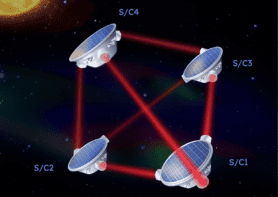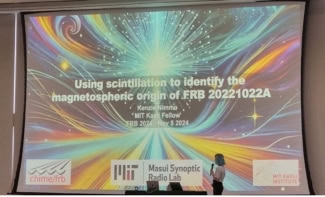Dark energy - the mysterious stuff thought to be causing the expansion of the universe to accelerate - could be the result of eight fields interacting via a "seesaw mechanism". This is the claim of physicists in Finland and Denmark, who say that the fields would be incarnated by a single, very light particle (Phys. Rev. Lett. 99 031301).

The top-contender for dark energy is the cosmological constant, which predicts that quantum fluctuations existing in the vacuum could create a constant energy density throughout space. But another dark-energy contender is quintessence, a scalar field with a negative pressure that, on large scales, would overcome the attractive force of gravity.
Unlike the cosmological constant, quintessence would be able to vary with time, thus explaining why the acceleration has only become significant in the past five billion years or so. Unfortunately, the particle-like mass associated with quintessence’s scalar field would have to be more than 38 orders of magnitude smaller than an electron, and so would easily be wiped-out by the vacuum fluctuations.
Kari Enqvist from the University of Helsinki and colleagues from the University of Aarhus, however, say they can solve this problem by borrowing an idea from particle physics that explains why neutrinos in the Standard Model are observed to have a very small, but not zero, mass. Called the seesaw mechanism, it suggests that the observed left-handed neutrinos – that is, those spinning anticlockwise in the direction they are travelling – can get their small mass if the equations are “balanced” by much heavier, right-handed neutrinos.
But to explain quintessence with a seesaw mechanism, say Enqvist and colleagues, you would not need just two types of particles, but eight different scalar fields. Each of these fields would be associated with a large particle of mass 1 TeV or more, but would interact to produce a single “physical” quintessence particle with a very small mass. Crucially, this particle would be protected from vacuum fluctuations, because they would only act on all eight fields as a whole.
Although eight fields may sound a little far-fetched, they would also have just the right properties to explain the early “inflation” era of the universe when the expansion was exponential. According to Martin Sloth, one of the Aarhus researchers, this would mean future observations of the cosmic microwave background – radiation left from an era after inflation – could shed light on the new theory’s credibility.
“Since explaining dark energy is a very challenging problem…it is certainly worth looking into such ideas,” Josh Frieman, the physicist who originally highlighted the problem of a small quintessence-particle mass, told physicsworld.com. Speaking about the possibility of eight dimensions, he added: “That could be the right explanation, but one might still hope that in the end nature is more parsimonious.”



